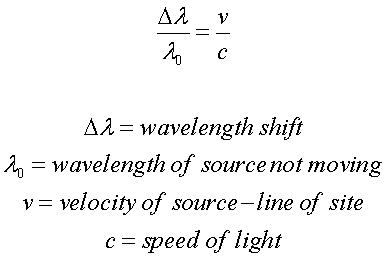A Doppler shift is a phenomenon of a change in
frequency based on the observers point of view. The
most common analogy of this is standing on the side
of the road and listen to a passing car. As the car
approaches, there is a definitive sound. As the car
passes, the sound changes to a lower frequency. This
is called a Doppler Shift. There are two types of
Doppler shifts:
- Red-Shift or a shift of
frequency to a lower
wavelength (away from the observer)
- Blue-Shift or a shift of
frequency to a
higher wavelength (toward the observer)
Anything that emits wavelengths -
light,
radio,
gamma rays, and the rest of the
E-M Band - and
changes
frequency due to movement, a Doppler shift
can be measured. This is the equation:

By measuring the Doppler shift of an
object, it is possible to measure the
velocity of
that object:

Back to Top
|

